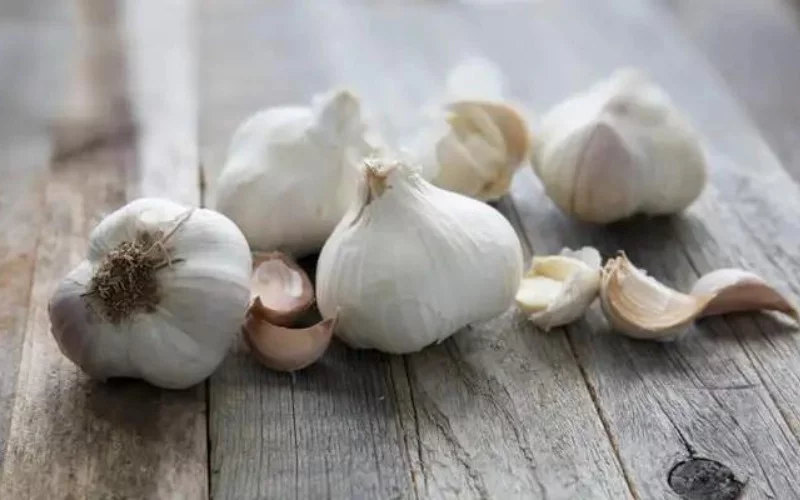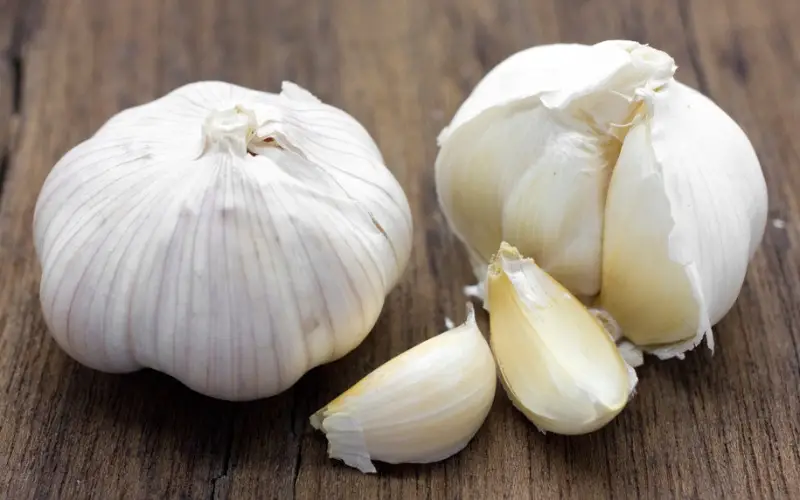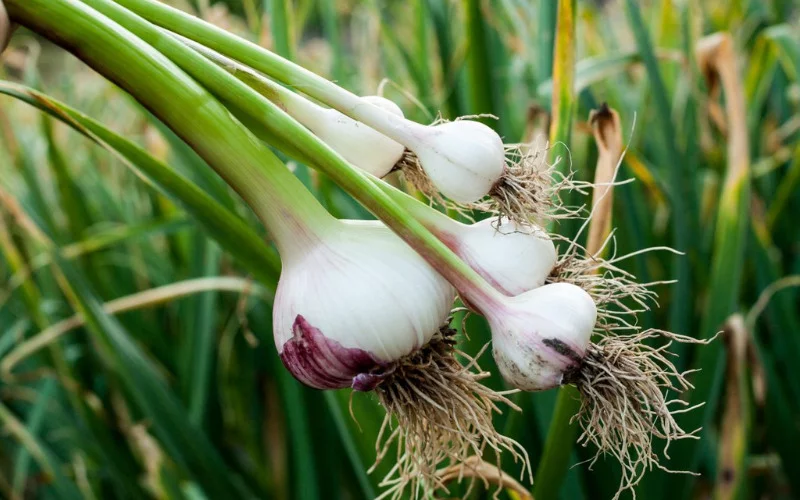Despite its strong smell, garlic is known to be one of the most useful and healthy spices that can be found in a kitchen, and it also helps that it can be used in various ways.
If you use garlic a lot, growing some in your yard or garden would be more reasonable than buying them. Growing garlic on your own also allows you to select what variety suits you.
Reading further, you will discover how to plant garlic heads, harvest them, and store them. We also discuss some varieties of this vegetable and the appropriate environment that should be provided for growth.
Varieties of Garlic
You may or may not be aware of the varieties of garlic, but it is important to know more about this information before planting.
This is because you may prefer to use one variety over the other when preparing meals. There are three major varieties of garlic; Hardneck garlic, soft-neck garlic, and elephant garlic.
1. Hardneck Garlic (Allium sativum ophioscorodon)

This variety of garlic has a hard stalk that grows to the center of the garlic. Because of their hardiness, they are preferred to be used in regions with cooler climates and offer a sharper flavor than softneck garlic.
Hardneck garlic can be identified by some stain of pin or purple on its white layer. When cut, you can see the stalk running to the bottom of the bulb.
Hardnecks are bigger than softnecks because they have bigger cloves and offer less trouble when peeling.
However, hard neck garlic does not last long as its shelf life ranges from 3 to 4 months with curing. They fall into the following categories; Rocambole, Porcelain, purple stripe, Creole, and Asiatic.
2. Softneck garlic (Allium sativum sativum)

Softneck garlic has a softer stalk that doesn’t go all the way down, and its stalks can be braided for easy storage. This type of garlic can be found in most supermarkets or grocery stores; it has a milder flavor than hardnecks and is best suited for use in regions with warmer climates like the southern climates.
Softneck garlic can be identified easily by its appearance as they are all white; when cut, there is no stalk running to the bottom as it becomes completely absent after chopping the top off.
This variety of garlic has a longer shelf life as it can be stored for as long as six months with curing, and they tend to be smaller in size with more cloves that are also small compared to that hardneck garlic.
Softnecks may give you a tough time peeling them; this variety falls under the artichoke or silverskin categories.
3. Elephant garlic (Allium ampeloprasum)

This is a different species of garlic, as they are very large. They are not true garlic as they are closely related to leeks and pearl onions; elephant garlic is mostly grown in the north and south.
Growth Requirements For Garlic
Like any other plant, garlic needs to be grown with specific factors. These conditions allow the garlic to come out just the way you want it; here are some of the basic growth requirements for this plant.
1. Water Requirement
Garlic is not a water-loving plant, so you must keep the soil moist but not waterlogged. The amount of water you supply to this plant should reduce as it grows, and about 3 to 4 weeks before harvest, allow the soil to be completely dry.
2. Sunlight And Temperature
Garlic thrives under full sunlight, so it is important to ensure that the space in your yard has access to 6-8 hours of sunlight before planting.
However, at the beginning of its growth, it will need a slightly cooler temperature of about 32 to 50°F, and upon maturity, it can tolerate full sunlight. If the soil of this plant freezes during cold periods, the growth will be resumed during spring, and at this time, you should also resume watering it.
3. pH
The ideal soil for this plant should be slightly acidic or neutral. When your soil is tested, the pH scale should read between 6.0 to 7.5. If your soil is basic, lime is a great solution for returning it to its ideal state.
4. Soil requirements
Well-drained humus soil is best for growing this vegetable. While this plant must get the necessary nutrients, you should know that excess application of nitrogen-based fertilizers can cause it to lose its taste.
How To Plant Garlic Heads
Garlic heads can be planted by separating the cloves and burying them in the soil. Avoid using store-bought garlic for planting as they only yield small ones.
This can be because it has been treated with various chemicals. You can follow the steps below to plant garlic heads the right way.
- Prepare the soil for planting by adhering to the right soil requirements and loosening it as far as 8 inches
- Obtain some fresh garlic heads and break them apart into cloves. This should be done carefully to prevent them from getting bruised or damaged.
- Planting large cloves will yield large bulbs, while small cloves will yield small bulbs.
- Each clove should be planted 1-2 inches into the ground and placed 6 to 8 inches apart.
- Each row of garlic should be spaced 12 inches apart
- If you have some fertilizer (organic or inorganic), you should add it now
- Plant garlic during fall (Late September to November), and in areas with severe cold climates, plant your cloves 6-8 weeks before fall.
- After planting, cover your garlic with mulch to help it survive during frost
- Harvest your garlic during summer (between June and august)
How To Harvest Garlic
The best time to harvest garlic is when the stalk is completely dry, and the foliage has started to turn yellow. But it is recommended that you harvest just one bulb at the start to ensure the others are ready to be harvested.
Pull or dig out one of the bulbs and observe it. Its cloves should be plumb and have a dry and papery texture. Pulling out the bulbs early will cause them to have thin skins; pulling them out too late will cause the bulb to split open. This can lead to an attack by diseases.
How To Store Garlic Heads
After harvesting your garlic, allow them to sit in a dry and well-ventilated room for about two weeks; then, you can transfer them to your kitchen baskets. When the garlic is completely dry, you can remove the dirtiest wrapper and brush away other dirt with a dry cloth.
An ideal storage condition for garlic is in a cool, dry room with enough air circulation. Avoid storing these vegetables in a humid environment as they can start sprouting; however, storing them right makes their shelf life longer.
FAQs
This section covers some frequently asked questions related to planting and growing garlic. These are additional details that could be helpful to some individuals.
Can I Grow Garlic In a Pot?
If you want to start small, a great way to accomplish this is by growing garlic in a pot. To grow garlic in pots, you must decide what variety to grow and the suitable container.
You can use plastic, glazed ceramic, plastic-stone pot, or fiberstone; these containers should be able to withstand cold weather as they will be left outside during frost.
Do Garlic Gets Attacked By Pests?
Pest infestation on garlic is quite common, and when this happens, you may notice some signs like discoloration, wilting, damaged foliage, stunted growth, scarring, and distorted bulbs.
Some common pests and diseases of this plant include white rot, onion thrips, and onion maggots; they can be controlled by some homemade solutions, using pesticides, getting rid of the infected plant, or by cultural and biological practices.
How Long Does It Take Garlic To Grow?
Garlic is planted during fall and harvested in summer, so it takes about ten months to grow fully. The time frame is long because, during frost, the growth of the bulbs is temporarily paused until spring before it resumes its growth.
Conclusion
Garlic is great for preparing many meals, and if you want to have access to these bulbs anytime, you can grow yours in your yard or garden.
This plant is not very demanding, so you can grow it easily and using this article as a guide, you should be able to plant and harvest the garlic you want.
We have explored the varieties of garlic and their features, how to plant them, their growth requirement, and how to harvest them. All these and the FAQ section should provide all the information you need about planting garlic heads.
Helpful Links:
- Can You Plant a Head of Lettuce
- Tips for Growing Lavender in Florida
- What Do Goat Head Plants Look Like?
- How to Grow Yellow Daisies in Your Garden
- What Causes White Spots On Tomato Leaves?
We trust this article helped you learn how to plant garlic heads. You may also want to check out if you Can Plant The Seeds From a Sunflower Head.
Thanks for taking the time to read our article, and we hope you find it helpful. Would you mind leaving a comment below if you have any suggestions?
Kindly reach out to people by sharing this post on social media.
If you liked this article, then please follow us on Facebook, Instagram, Twitter, and Pinterest.

